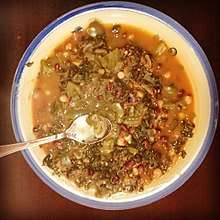Githeri

Githeri (Gĩtheri), also called muthere or mutheri, is a Kenyan traditional meal of maize and legumes, mostly beans of any type mixed and boiled together.[1] The maize and beans are mixed together in a sufuria or pot, water is then added and the mixture boiled until the food is cooked and ready to eat.[2] It was and still is the staple food of the Gikuyu, Meru and Embu people in the Central Province of Kenya, but it is also eaten in other parts of the country. Githeri is also popular among the Kamba people of Eastern province of Kenya. [1]The beans and maize can either be fresh or dry. Most people prefer the fresh ingredients because of the taste. It is easy to access because maize and beans are readily available in these areas since they are mostly gotten from the farm. Githeri is eaten as a maize and bean mixture (mũrũgarũgio or one-by-one).
It can also be made into a stew with the addition of vegetables, meat, and potatoes. Githeri is also used to make mukimo after the addition of potatoes, bananas, and greens, and mashing up the mixture. Lately there has been an upsurge in the consumption of githeri due to the health benefits associated with the dish. Secondary schools are also credited with the popularization of this dish because it is the main meal served to students since the 1920s. Eating githeri has also become trendy with young people. Many hotels in Kenya also serve githeri.[1]
Health benefits
- Is wholesome and not processed
- Is a high fiber dish
- Contains no sugar
- Has high nutritional value
- It's prepared from locally available ingredients making it affordable to many
- When prepared with vegetables it provides a balanced diet making it the most affordable source of all nutrients one requires
Terms associated with githeri
Gikuyu language
- murugarugio - Githeri put in a plate direct from the pot, with only salt added to it. murugarugio comes from the Kikuyu meaning moving up and down. once the salt is put the plate is shaken up and down.
- gikangu (pronounced gy-kah-ngoh) - Cold githeri with more maize than beans. Traditionally was cooked in poor households and served to school going children.
- kagoto - Ballast in English; this is a slang name for githeri used by secondary school students in Central Province.
- mbegu - Seeds; the githeri is described as seeds because it contains whole maize and beans.
- mukimo - Githeri mixed with potatoes, greens and bananas, then mashed together.
- mutheri - Another name for githeri.
- muthungu - Githeri made out of maize exclusively without beans. Muthungu means "the white man" which is a fitting name for a dish full of white seeds.
- Kibecu - Slang word for Githeri amongst young Kikuyu's.
Kamba languange
- Isyo - General name for githeri.
- Mukeu - Githeri made of undried (fresh) corn and legumes(beans).
- Muthakyo - Githeri which has only been boiled and is served without any soup in it.
- Muthokoi - Githeri with corn whose testa (seedcoat) has been partially removed.
Luo Language
- Nyoyo - general name for githeri in Luo.
Slang
- Uram - Swahili slang (sheng) for githeri; popularly among high school students.
See also
- Kenyan Cuisines
References
- 1 2 3 "Kenya Food Facts | Ethnic Dishes | Popular Kenyan Cuisine". kenya-information-guide.com. 2015. Retrieved 27 August 2015.
- ↑ "Githeri Recipe (Kenyan corn and beans)". whats4eats.com. Retrieved 27 August 2015.